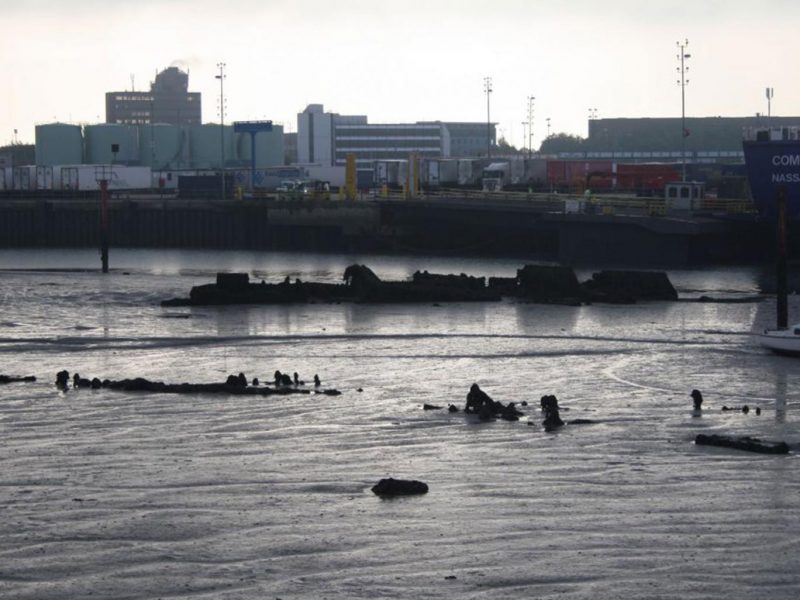Decades after disappearing, two World War I German warships have been found peaking above the tide in Portsmouth Harbour. The discovery was the result of archaeologists’ research into aerial photographs from the 1940’s and local newspapers from the 1920’s.These two destroyers are a rare breed. Researchers concur that they must be among the few remaining vessels of the Imperial German Navy that can be occasionally seen above water.
These archaeologists think the vessels are V44 and V82, which set off from the German port of Kiel in February 1915 and July 1916. The V44 is particularly well-known and significant due to its function in the war. It played a crucial role in the great strategic escape of the German fleet in May 1916 after the key phase of the Battle of Jutland.
This vessel was one of the only ones to successfully torpedo the British as the 93 remaining ships of the Imperial German High Seas Fleet were pursued under fire.
Seventy German warships were forced to surrender to the Royal Navy in November 1918. The V44 and V82 destroyers were in that mix and were interned in Scapa Flow Harbour in the Orkneys. In June 1919, German Navel personnel decided to violate the Allied/German armistice agreement. The men on-board the captured ships plotted to fly the battle ensigns and then scuttle their entire fleet. The plot was hugely successful in that the majority of the vessels were sunk.
The Germans felt sinking the ships was better than the alternative of the Royal Navy maintaining permanent possession over them. However, two dozen vessels (including the V44 and V82) were not sunk because Royal Navy Officers were able to arrive on scene before the Germans opened the bilge valves to flood them. In those instances, the British gained control of the vessels.
Portsmouth was the Brits’ destination for the V44, V82 and a cruiser called the Nürnberg. There the vessels were used for naval big-gun target practice. The Nürnberg was eventually sunk in the English Channel, but the destroyers were intentionally brought onto the beach by the Royal Navy near Whale Island in the eastern part of the Portsmouth Harbour.
Unfortunately, in the early part of the 1920’s, the two destroyers were looted for scrap metal by thieves. Later on in that same decade, the ships were sold for scrap. Remnants not plundered by the scrap merchants (for example the ships’ hulls) became abandoned and ultimately forgotten. One of the two vessels is thought to still have its boilers and additional machinery still intact.
It took another eight decades for archaeologists to find the vessels. Britain’s Maritime Archaeology Trust will conduct detailed surveys of both vessels, but they are only visible when the tide is very low. Despite low tide, the vessels can still be hard to access due to the very dangerous quicksand-style mudflats.
Researchers from the Maritime Archaeology Trust have examined local paintings from the 1920s along with archival sources. Their findings indicated that there are additional World War I German vessels that are abandoned or buried in nearby mud. There might even be a submarine in the mix. It will take an aerial view obtained via drone to determine what exactly is left of the two destroyers.
But now the search will extend to other missing German vessels. New data facilitates the opportunity for archaeologists to make 3D models of the destroyers. The entirety of each wreckage resides in an area that is owned and controlled by the Royal Navy to this day.
Stephen Fisher is one of the lead research officers for Maritime Archaeology Trust’s Forgotten Wrecks of the First World War project. He stated, “Our research demonstrates that there are still major relics from the First World War waiting to be discovered. These two German destroyers are important because of the significant role they played in trying to control the seas around Britain during the conflict.” The Heritage Lottery Fund is financially backing the entire Forgotten Wrecks project.
Thus far, researchers have made incredible strides on this project. They have successfully recorded 1,100 First World War wrecks located near England’s south coast. It is believed that roughly 700 are British, of which most are merchant vessels. Another 50 are German, with a majority believed to be submarines. The rest are merchant ships of a dozen other nationalities. It is likely that any of the non-German ships discovered had been sunk by German submarines in the midst of the war.
